 Software Tutorial
Software Tutorial
 Office Software
Office Software
 How to set several continuous animations in PPT_How to set several continuous animations for an object in PPT
How to set several continuous animations in PPT_How to set several continuous animations for an object in PPT
How to set several continuous animations in PPT_How to set several continuous animations for an object in PPT
Do you need to let the objects in PPT perform a series of continuous animations? PHP editor Banana is here to answer your question! This article will introduce in detail how to set multiple continuous animations for a single object in PPT, from adding animation to adjusting its order and duration. Read on to master this powerful feature to make your PPT presentations more eye-catching and dynamic.
Step one: Draw a rectangular table and a diagonally placed wooden board in PPT, insert a circle on the table, set the filling and other formats as a small ball.
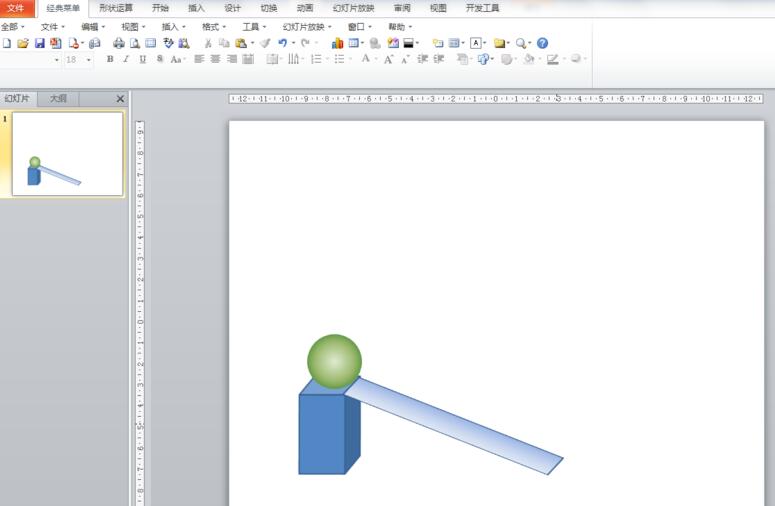
Step 2: Select the ball, click the [Animation] tab, click the [Add Animation] button in the [Advanced Animation] group, and select the [Enter] type [Fly in], click [Effect Options] in the [Animation] group, select [From Top] in the pop-up drop-down list, and keep the [Start: When clicked] setting unchanged in the [Timing] group.
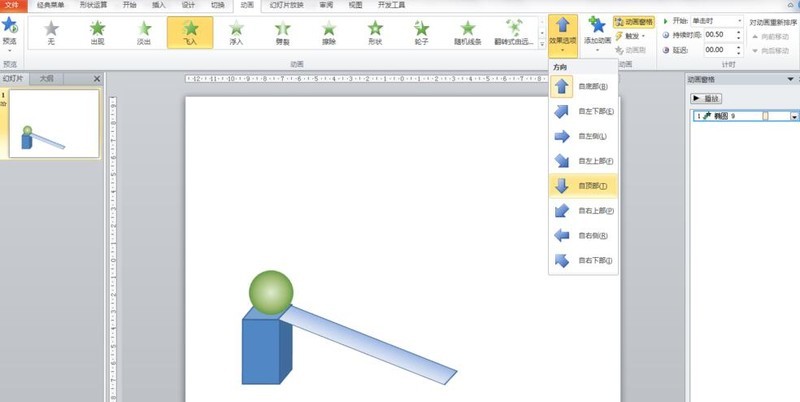
Step 3: Click the [Animation Pane] button in the [Advanced Animation] group to open the animation pane, right-click the animation effect in the animation pane, and select it in the drop-down list Select [Effect Options], then set [Bounce End: 0.25] in the dialog box that opens, and click [OK].
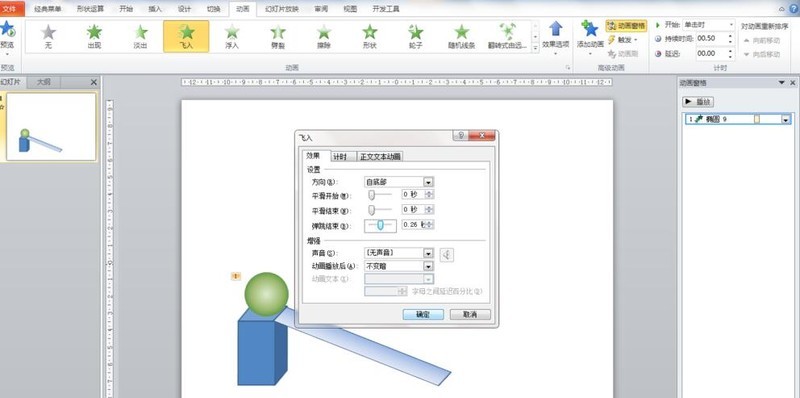
Step 4: Select the ball again, click the [Animation] tab, click the [Add Animation] button in the [Advanced Animation] group, and select [ Other action paths], then select [Diagonal to the lower right] in the dialog box, and click [OK]. After the settings are completed, adjust the direction and length of the path in the slide pane.
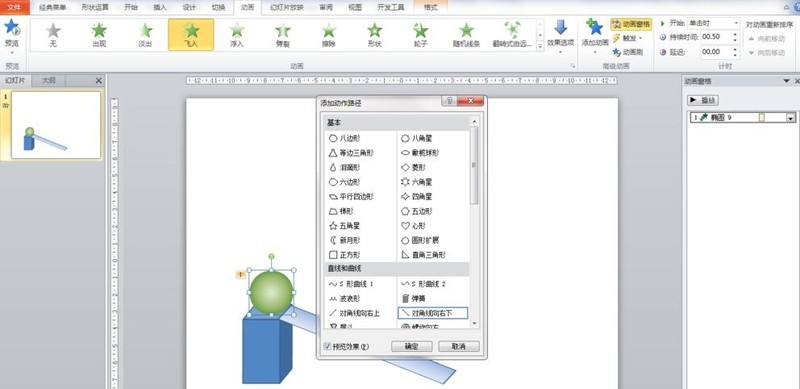
Step 5: Select the ball for the third time, click the [Animation] tab, click the [Add Animation] button in the [Advanced Animation] group, and click the [Add Animation] button in the drop-down list Select [Action Path], then click [Free Path]. The mouse draws a free path at the end position of the previous animation path. Then the drawn path bounces to the position of the ball. Drag the mouse to the position of the drawn path, and the previous Path animation connection.
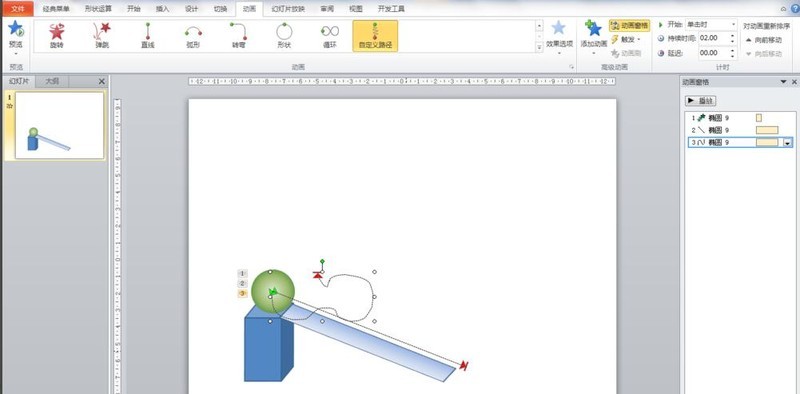
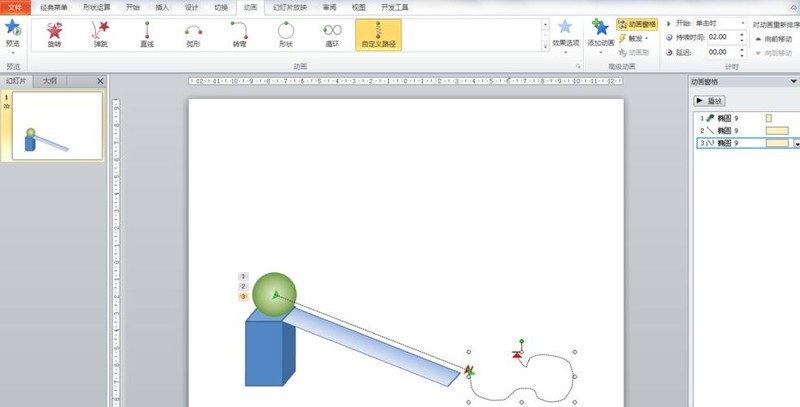
Step 6: If an animation effect appears when you click once, the setting is complete. As shown in the figure, let three animations play continuously. Select the next two path animations at the same time in the animation pane, right-click, and set [Smooth Start: 0 seconds] and [Smooth End: 0 seconds] in the dialog box that opens, and click [ Sure】. In addition, it is also very important to set the last two path animations in the [Timing] group [Start: after the previous animation].
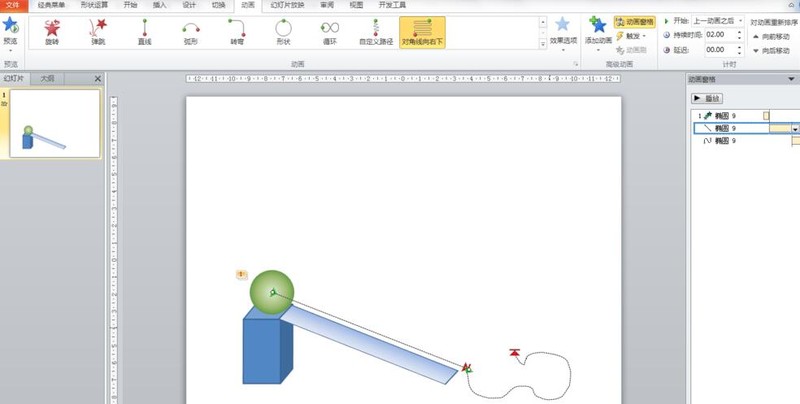
The above is the detailed content of How to set several continuous animations in PPT_How to set several continuous animations for an object in PPT. For more information, please follow other related articles on the PHP Chinese website!

Hot AI Tools

Undresser.AI Undress
AI-powered app for creating realistic nude photos

AI Clothes Remover
Online AI tool for removing clothes from photos.

Undress AI Tool
Undress images for free

Clothoff.io
AI clothes remover

Video Face Swap
Swap faces in any video effortlessly with our completely free AI face swap tool!

Hot Article

Hot Tools

Notepad++7.3.1
Easy-to-use and free code editor

SublimeText3 Chinese version
Chinese version, very easy to use

Zend Studio 13.0.1
Powerful PHP integrated development environment

Dreamweaver CS6
Visual web development tools

SublimeText3 Mac version
God-level code editing software (SublimeText3)

Hot Topics
 1662
1662
 14
14
 1418
1418
 52
52
 1311
1311
 25
25
 1261
1261
 29
29
 1234
1234
 24
24
 If You Don't Rename Tables in Excel, Today's the Day to Start
Apr 15, 2025 am 12:58 AM
If You Don't Rename Tables in Excel, Today's the Day to Start
Apr 15, 2025 am 12:58 AM
Quick link Why should tables be named in Excel How to name a table in Excel Excel table naming rules and techniques By default, tables in Excel are named Table1, Table2, Table3, and so on. However, you don't have to stick to these tags. In fact, it would be better if you don't! In this quick guide, I will explain why you should always rename tables in Excel and show you how to do this. Why should tables be named in Excel While it may take some time to develop the habit of naming tables in Excel (if you don't usually do this), the following reasons illustrate today
 How to change Excel table styles and remove table formatting
Apr 19, 2025 am 11:45 AM
How to change Excel table styles and remove table formatting
Apr 19, 2025 am 11:45 AM
This tutorial shows you how to quickly apply, modify, and remove Excel table styles while preserving all table functionalities. Want to make your Excel tables look exactly how you want? Read on! After creating an Excel table, the first step is usual
 You Need to Know What the Hash Sign Does in Excel Formulas
Apr 08, 2025 am 12:55 AM
You Need to Know What the Hash Sign Does in Excel Formulas
Apr 08, 2025 am 12:55 AM
Excel Overflow Range Operator (#) enables formulas to be automatically adjusted to accommodate changes in overflow range size. This feature is only available for Microsoft 365 Excel for Windows or Mac. Common functions such as UNIQUE, COUNTIF, and SORTBY can be used in conjunction with overflow range operators to generate dynamic sortable lists. The pound sign (#) in the Excel formula is also called the overflow range operator, which instructs the program to consider all results in the overflow range. Therefore, even if the overflow range increases or decreases, the formula containing # will automatically reflect this change. How to list and sort unique values in Microsoft Excel
 How to Format a Spilled Array in Excel
Apr 10, 2025 pm 12:01 PM
How to Format a Spilled Array in Excel
Apr 10, 2025 pm 12:01 PM
Use formula conditional formatting to handle overflow arrays in Excel Direct formatting of overflow arrays in Excel can cause problems, especially when the data shape or size changes. Formula-based conditional formatting rules allow automatic formatting to be adjusted when data parameters change. Adding a dollar sign ($) before a column reference applies a rule to all rows in the data. In Excel, you can apply direct formatting to the values or background of a cell to make the spreadsheet easier to read. However, when an Excel formula returns a set of values (called overflow arrays), applying direct formatting will cause problems if the size or shape of the data changes. Suppose you have this spreadsheet with overflow results from the PIVOTBY formula,
 Excel MATCH function with formula examples
Apr 15, 2025 am 11:21 AM
Excel MATCH function with formula examples
Apr 15, 2025 am 11:21 AM
This tutorial explains how to use MATCH function in Excel with formula examples. It also shows how to improve your lookup formulas by a making dynamic formula with VLOOKUP and MATCH. In Microsoft Excel, there are many different lookup/ref
 Excel: Compare strings in two cells for matches (case-insensitive or exact)
Apr 16, 2025 am 11:26 AM
Excel: Compare strings in two cells for matches (case-insensitive or exact)
Apr 16, 2025 am 11:26 AM
The tutorial shows how to compare text strings in Excel for case-insensitive and exact match. You will learn a number of formulas to compare two cells by their values, string length, or the number of occurrences of a specific character, a
 How to Use Excel's AGGREGATE Function to Refine Calculations
Apr 12, 2025 am 12:54 AM
How to Use Excel's AGGREGATE Function to Refine Calculations
Apr 12, 2025 am 12:54 AM
Quick Links The AGGREGATE Syntax




